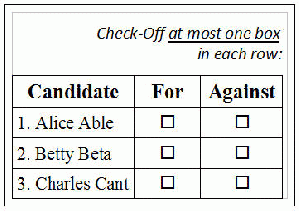Not only in the United States, but throughout the world, nearly every election for political office is conducted using plurality voting. Mostly out of habit, we use it, only rarely even considering alternative systems that promise to work better.
Name recognition is widely recognized as vital for a candidate since few if any voters will vote for a an unknown candidate. So celebrities get a big head-start while others face a nearly impossible hurdle merely to become known widely enough to make election even a remote possibility. This is characteristic of a plurality election, but also with many other systems of voting.
Celebrities nearly always have admirers but often they have enemies as well. But in a multiple candidate contest conducted with plurality voting, enemies do not matter. The celebrity gains advantage with any system where opposition matters little. Plurality voting only allows the voter to vote for one candidate and gives no opportunity to vote against a candidate (unless there are exactly two candidates up for election).
We are accustomed to the idea that the rich or famous enjoy great advantages in life but should should that advantage be allowed to usher a celebrity into office? Instead, why not give voters the additional option of voting against a candidate while retaining the alternative of voting for a candidate. In the tally of votes, each vote against a candidate would cancel a vote for that candidate. That is a simple change that will mean that the celebrity who is loved and hated in equal proportion will start with no significant advantage (other than perhaps money and connections) over a little known but qualified candidate for office.
Each of the most widely-familiar alternative voting systems fails to allow explicit votes against a candidate and this missing ingredient that is the focus of this series of articles. Plurality Voting, IRV, Approval Voting and Range Voting, have each been described in this series and we have shown each to have a near-twin that provides the voter with exactly the same opportunity to vote against a candidate as to vote for a candidate. Any of these balanced voting systems help level the playing field to give nearly an equal opportunity to less widely known candidates to win.
An earlier article in this series suggests that Balanced Approval Voting may be the best alternative voting system, at least if multiple party politics is the objective. But especially because BAV will encourage many parties to form, it could in time suffer from its own success and generate a seemingly unmanageable number of candidates.
With BAV, a voter is asked to go through the entire list of candidates and indicate either for or against for each. If an election is between only five or six candidates then this seems to be a quite reasonable request but if there are fifty or a hundred candidates then voting would become an unmanageable chore. To some extent, BAV anticipates this by allowing the voter to simply go through the list and only mark the candidates of real interest to the voter.
Holding just a few such elections in this way would provide some interesting statistical data. It would be interesting to know how many candidates were, on average, marked in a typical election. My own guess is that it would not be many.
But might this approach, allowing the voter to choose the number of candidates to list, grant more influence to voters who choose to mark more candidates? Even though that is a choice each voter makes, it may seem just a bit unfair. There may be ways to exploit this uneven influence to one or another candidate's advantage. But perhaps we could nip this potential problem in the bud.
Let me remind you of a system we might call Balanced Plurality Voting. Though the name is new, I described the system in a very early in this series. It is probably the simplest possible system of balanced voting. BPV is like plurality voting except that it allows a vote to be cast against a candidate as well as for a candidate.
We can build on BPV to define new balanced voting systems that I call Balanced Ration Voting. In these systems, each voter receives an identical ration of BRV ballots. This done in recognition of the limits our memory and our ability even to form considered opinions about more than just a few candidates for office. BRV(8), for example, provides each voter with a ration of eight BPV ballots to fill out. The voter can choose to cast all eight votes against one candidate or all eight votes for one candidate. Just as easily, a voter can choose to vote one candidate twice, another once and against five other candidates.
In a recent article, we observed that an explanation for the apparent popularity of IRV seems to be that it does offer the voter the pleasure of discriminating between a candidate the voter likes and another that she likes even more. In another recent article, we also observed that range voting also allows the voter this possibility. BRV shares this feature as well.
As with range voting, BRV allows a voter to allocate to one (particularly favored or disfavored) candidate several votes but only at the cost of not being able to vote for as many different candidates. This prevents the voter from favoring-in-the-extreme, all favored candidates (as would be the great temptation with range voting).
The number 8 for this example was arbitrary, of course, but arrived at by assuming that a typical voter could have formed firm opinions about perhaps only five different candidates. The extra three ballots could be used to express particular emphasis on a few of those.
A nice application of BRV is shown in an article later in this series and it comes up again in the three overview articles beginning here.






